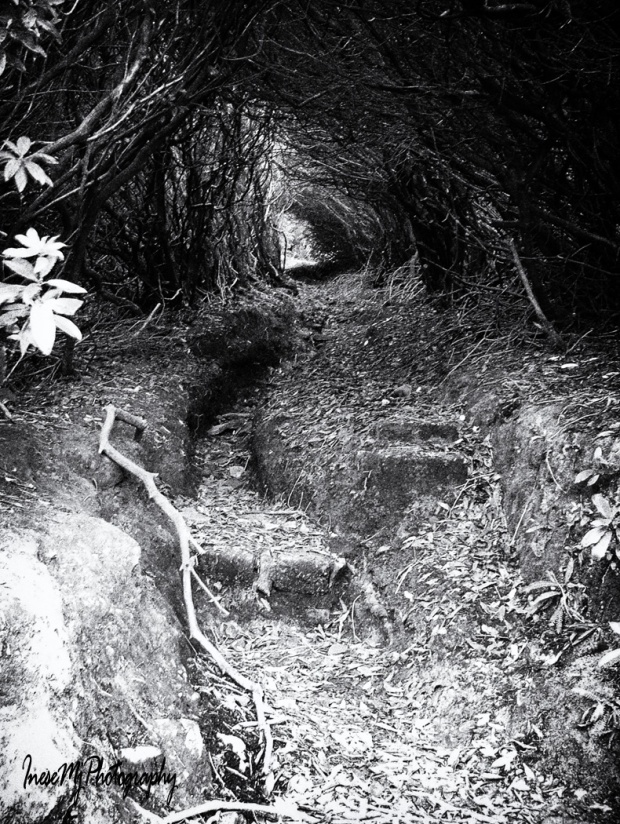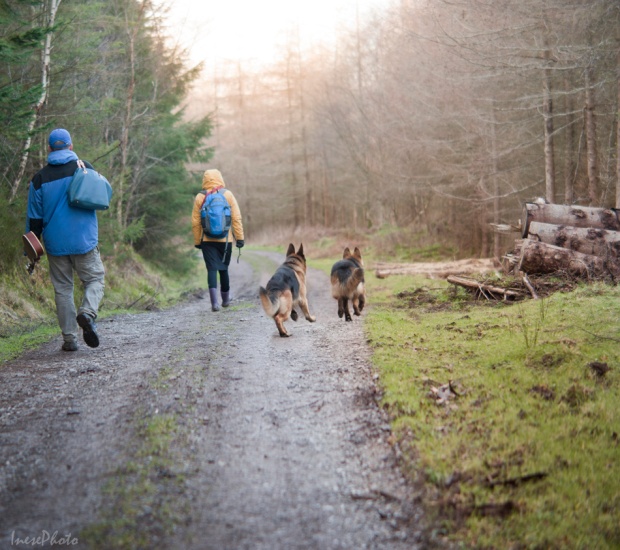We are visiting Crotty’s places, and Coumshingaun is next on the list. I will write more about the lake in January. Today I want to tell you about a man who had lived around there most of his life, 200 years after William Crotty.
The Hermit Lackendarra.
This picture is linked to the blog of a native of Kilmacthomas Tom O’Brien, novelist, playwright and poet living in Hastings UK. Tom wrote the hermit’s story in 2014, sharing his own memories as he grew up in the area. My plan was to write about Lackendarra in 2019, on the occasion of the 100th anniversary of his settling in the Comeraghs, but none of my plans have been working since… Yet, I didn’t give up on the idea. In November, I met a solo hiker who mentioned the hermit, and I knew it was the time to finally put up a blog post.
I had never been to the hermit’s cave, but I had a map from Barry Dalby of EastWest Mapping and spotted the rock from the main road. It took a while though, but on a fine and chilly December day I was finally standing there, as close as I could get to the place. The rock looked massive, its surface was glowing in the low winter light.

Before he became known by the name of Lackendarra, Jim Fitzgerald was a young lad raised by his grandparents in the townland of Castlereagh near Lackendarra on the other side of the Comeraghs. According to Census, he was born in 1891, and it also fits with the record of his death in 1959 at the age of 68.
Jim enlisted with the Royal Irish Regiment in 1914 and was sent to Mesopotamia with the 1st Bn Connaught Rangers in 1916. In 1918, he was discharged with diagnosis “melancholia” due to suffering a severe shell shock, a broken man, physically and mentally.
Unable to fit in and keep a job, he went to the mountains looking for a place to live away from society.
After days of search, he came across a cavern in the cliff behind Coumshingaun lake. It seems the cavern was the one where William Crotty used to hide his horses and stolen cattle.
“A few nights after his arrival, he had been awakened by the piercing wails of a woman and the agonizing groans of a man. The sounds were followed by the clip-clop of hoof beats and the echoes of clashing steel. After the some time the tumult had retreated along the tunnel – way to the north, and faded away…
The unearthly noises had continued every night without any variation, until his nerves eventually forced him to depart. “I thought Crotty’s ghost was after me and I could not suppress the fear that his gander resented my presence”.
Old Jim of the Comeraghs by John Scarry, The Wide World Magazine: Vol. 118, No. 700, November 1956
Jim left the cavern, but used a cave under the fallen rocks as his summer residence.

Before I continue with the story about my hike, I want you to watch this amazing video by Tom Fitzpatrick and learn more about The Hermit Lackendarra. It is a 17 minute video and some extras, not a single minute too long. I share this video to celebrate all the kind people who took care of a stranger, a broken man, expecting nothing in return.
Lackendarra from Tom Fitzpatrick on Vimeo.
*
I parked at Kilclooney Wood car park and being a polite (and curious) person started a small talk with these two gentlemen getting ready for their hike. The weather was extremely windy and chilly. I couldn’t miss noticing their serious hiking gear which meant they were up for the 4 hour cliff hike around the lake. My Sketchers walking shoes were noticed too, and frowned upon 😉 I asked about the Hermit’s cave and got the directions.
Meet the rock climbers – educator and mountaineer Jack Bergin and director of Dunmore East Sea School Robert Marchant.

I was glad I didn’t wear my Earth Spirit sandals that day… I wear them all the year round – just add an extra pair of socks in winter. They are great on the rocks and rugged terrain – I can feel the earth beneath my feet and never slip. Another good thing about them – I don’t do any damage to the soil and vegetation. It is very important for me because I often walk off the trails to take photographs. Even the Sketchers look heavy to compare with my favorite sandals.

This is an old photograph, and it was the view I expected, but there was no pine tree anymore. I couldn’t believe my eyes. It was an artificial pine tree, so it definitely wasn’t cut down for timber!

I looked around in confusion, and there it was, all broken into pieces.

Now I know what the tree was made from.

Instead of walking up the slope, I continue straight ahead until the path takes me to the stone wall. Then I just follow the wall. I wouldn’t walk here in summer because of the ferns and other thick vegetation.


I look back at the coum trying to spot the brave rock climbers. I don’t feel the wind here, but I have seen the forecast… Hope they are all right…

Finally I see the Lackendarra’s Rock. It is not as close as I expected, but I wouldn’t cross the fencing. I just stand there thinking about everything I know about the man.

I look back at the coum again. It is very tempting to walk to the lake from here. It is what Lackendarra would do. There is a sheep track, and I follow it.

The sheep track is winding between the ferns. The rocks grow bigger as I come closer, and smaller again when I look back.


At this point I decide to turn left to may be join the trail. The place feels like a wind tunnel and I worry about the lads.

Robins and rabbits distracted me. It was after 3PM when I finally got to the lake. There I met another hiker, Garreth, and we exchanged some bits of information about the area. When Garreth left, I had the whole coum to myself. It was quite dark, I took a few pictures of a shallow stream and walked towards the far end of the lake. It is a half of a mile long walk, and I wouldn’t go to the caves anyway, so I just took this picture from a distance. To get a sense of scale, look at the white dots – the sheep. The Crotty’s cavern is in the centre. On the right side of the cavern the rockfall created a series of caves where Lackendarra would stay in summer.

This is an older picture. The place doesn’t change much over the seasons.

I am delighted you learned another bit of Co Waterford history. More about the lake in my next blog. And yes, the brave rock climbers returned safe and sound at the time I was done with my photography.
I hope you had a happy Christmas. There are too many people in the world haunted by their memories, fears or pain. Sometimes they are too different for us to be comfortable with. They might feel the same about us. It is a fragile territory where only a pure compassion can operate. My New Year’s wish for you is that your life is full of love, joy and prosperity, and also compassion – the key to all good in this life.
Thank you for being friends.
 Merry Christmas and a Happy New Year!
Merry Christmas and a Happy New Year!

























































































 Have a wonderful weekend!
Have a wonderful weekend!

















 Have a wonderful weekend!
Have a wonderful weekend!